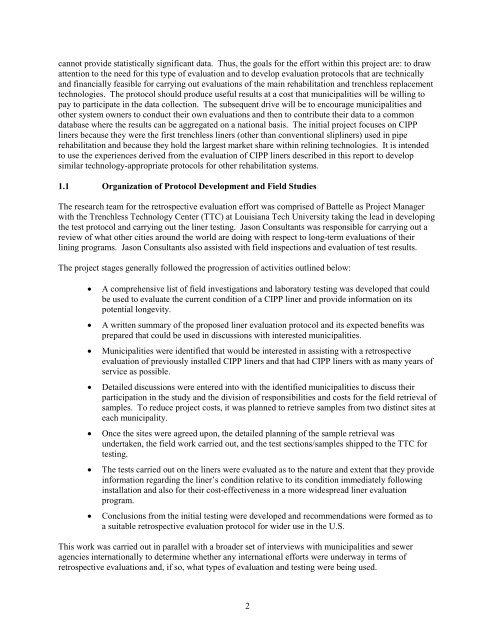Retrospective Evaluation of Cured-in-Place Pipe - (NEPIS)(EPA ...
Retrospective Evaluation of Cured-in-Place Pipe - (NEPIS)(EPA ...
Retrospective Evaluation of Cured-in-Place Pipe - (NEPIS)(EPA ...
Create successful ePaper yourself
Turn your PDF publications into a flip-book with our unique Google optimized e-Paper software.
cannot provide statistically significant data. Thus, the goals for the effort with<strong>in</strong> this project are: to draw<br />
attention to the need for this type <strong>of</strong> evaluation and to develop evaluation protocols that are technically<br />
and f<strong>in</strong>ancially feasible for carry<strong>in</strong>g out evaluations <strong>of</strong> the ma<strong>in</strong> rehabilitation and trenchless replacement<br />
technologies. The protocol should produce useful results at a cost that municipalities will be will<strong>in</strong>g to<br />
pay to participate <strong>in</strong> the data collection. The subsequent drive will be to encourage municipalities and<br />
other system owners to conduct their own evaluations and then to contribute their data to a common<br />
database where the results can be aggregated on a national basis. The <strong>in</strong>itial project focuses on CIPP<br />
l<strong>in</strong>ers because they were the first trenchless l<strong>in</strong>ers (other than conventional slipl<strong>in</strong>ers) used <strong>in</strong> pipe<br />
rehabilitation and because they hold the largest market share with<strong>in</strong> rel<strong>in</strong><strong>in</strong>g technologies. It is <strong>in</strong>tended<br />
to use the experiences derived from the evaluation <strong>of</strong> CIPP l<strong>in</strong>ers described <strong>in</strong> this report to develop<br />
similar technology-appropriate protocols for other rehabilitation systems.<br />
1.1 Organization <strong>of</strong> Protocol Development and Field Studies<br />
The research team for the retrospective evaluation effort was comprised <strong>of</strong> Battelle as Project Manager<br />
with the Trenchless Technology Center (TTC) at Louisiana Tech University tak<strong>in</strong>g the lead <strong>in</strong> develop<strong>in</strong>g<br />
the test protocol and carry<strong>in</strong>g out the l<strong>in</strong>er test<strong>in</strong>g. Jason Consultants was responsible for carry<strong>in</strong>g out a<br />
review <strong>of</strong> what other cities around the world are do<strong>in</strong>g with respect to long-term evaluations <strong>of</strong> their<br />
l<strong>in</strong><strong>in</strong>g programs. Jason Consultants also assisted with field <strong>in</strong>spections and evaluation <strong>of</strong> test results.<br />
The project stages generally followed the progression <strong>of</strong> activities outl<strong>in</strong>ed below:<br />
• A comprehensive list <strong>of</strong> field <strong>in</strong>vestigations and laboratory test<strong>in</strong>g was developed that could<br />
be used to evaluate the current condition <strong>of</strong> a CIPP l<strong>in</strong>er and provide <strong>in</strong>formation on its<br />
potential longevity.<br />
• A written summary <strong>of</strong> the proposed l<strong>in</strong>er evaluation protocol and its expected benefits was<br />
prepared that could be used <strong>in</strong> discussions with <strong>in</strong>terested municipalities.<br />
• Municipalities were identified that would be <strong>in</strong>terested <strong>in</strong> assist<strong>in</strong>g with a retrospective<br />
evaluation <strong>of</strong> previously <strong>in</strong>stalled CIPP l<strong>in</strong>ers and that had CIPP l<strong>in</strong>ers with as many years <strong>of</strong><br />
service as possible.<br />
• Detailed discussions were entered <strong>in</strong>to with the identified municipalities to discuss their<br />
participation <strong>in</strong> the study and the division <strong>of</strong> responsibilities and costs for the field retrieval <strong>of</strong><br />
samples. To reduce project costs, it was planned to retrieve samples from two dist<strong>in</strong>ct sites at<br />
each municipality.<br />
• Once the sites were agreed upon, the detailed plann<strong>in</strong>g <strong>of</strong> the sample retrieval was<br />
undertaken, the field work carried out, and the test sections/samples shipped to the TTC for<br />
test<strong>in</strong>g.<br />
• The tests carried out on the l<strong>in</strong>ers were evaluated as to the nature and extent that they provide<br />
<strong>in</strong>formation regard<strong>in</strong>g the l<strong>in</strong>er’s condition relative to its condition immediately follow<strong>in</strong>g<br />
<strong>in</strong>stallation and also for their cost-effectiveness <strong>in</strong> a more widespread l<strong>in</strong>er evaluation<br />
program.<br />
• Conclusions from the <strong>in</strong>itial test<strong>in</strong>g were developed and recommendations were formed as to<br />
a suitable retrospective evaluation protocol for wider use <strong>in</strong> the U.S.<br />
This work was carried out <strong>in</strong> parallel with a broader set <strong>of</strong> <strong>in</strong>terviews with municipalities and sewer<br />
agencies <strong>in</strong>ternationally to determ<strong>in</strong>e whether any <strong>in</strong>ternational efforts were underway <strong>in</strong> terms <strong>of</strong><br />
retrospective evaluations and, if so, what types <strong>of</strong> evaluation and test<strong>in</strong>g were be<strong>in</strong>g used.<br />
2















